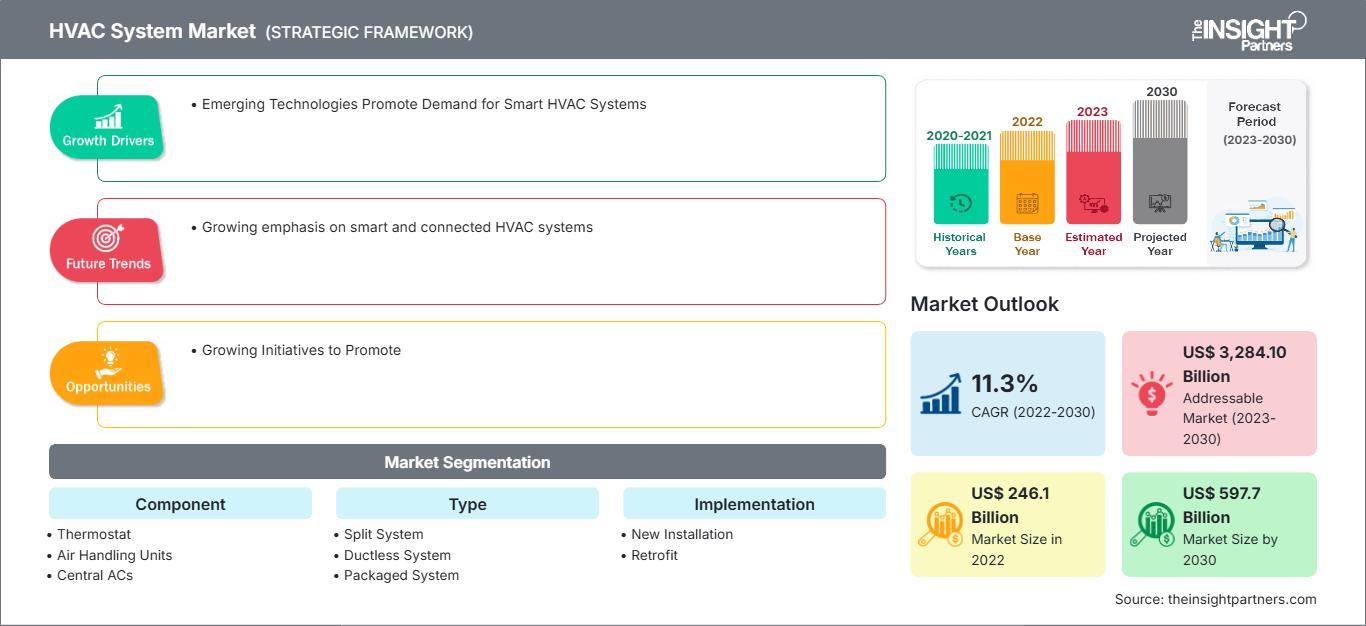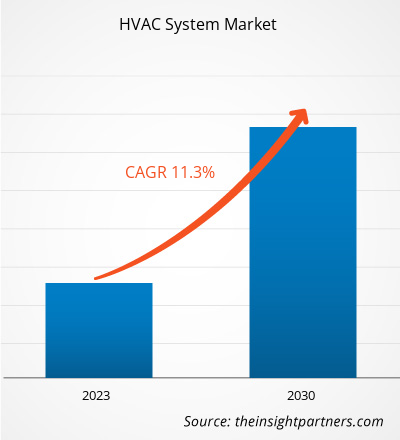Le marché des systèmes CVC devrait passer de 246,10 milliards de dollars américains en 2022 à 597,7 milliards de dollars américains en 2030 ; il devrait enregistrer un TCAC de 11,3 % entre 2022 et 2030. L’importance croissante accordée aux systèmes CVC intelligents et connectés pour améliorer l’efficacité énergétique globale devrait rester une tendance clé du marché.
Analyse du marché des systèmes CVC
L’essor de la demande en systèmes CVC écologiques et en maisons intelligentes a encouragé les acteurs à entreprendre des développements innovants dans les technologies CVC, en mettant l’accent sur l’amélioration de l’efficacité énergétique. D’importantes entreprises s’engagent dans des partenariats, des acquisitions, des innovations produits et des stratégies de développement. De plus, en 2023, le secteur du CVC s’oriente vers les systèmes connectés intelligents. Grâce à ces systèmes, les propriétaires et les gestionnaires d’immeubles peuvent contrôler leurs systèmes CVC à distance à l’aide d’appareils mobiles et de smartphones. Ces systèmes offrent un contrôle précis de la température et peuvent s’adapter automatiquement aux conditions météorologiques changeantes pour améliorer l’efficacité énergétique. De plus, l'essor des pompes à chaleur modifie les perspectives du marché des systèmes CVC, car il est nécessaire de réduire progressivement l'utilisation des réfrigérants HFC. Parmi les autres facteurs de changement, on peut citer une meilleure connectivité entre les systèmes.
Aperçu du marché des systèmes CVC
CVC est l'abréviation de Chauffage, Ventilation et Climatisation. Le terme CVC désigne un système complet de confort domestique capable de chauffer et de climatiser votre maison tout en améliorant la qualité de l'air intérieur. CVC est parfois confondu avec le terme AC, mais AC désigne uniquement la climatisation, tandis que CVC désigne l'ensemble du système, qui peut inclure ou non un climatiseur. L'objectif d'un système CVC est d'offrir un confort optimal à la maison. Pour ce faire, un système complet doit être assemblé : climatiseur, chaudière, appareil de traitement d'air, conduits, thermostat et éventuellement des équipements supplémentaires tels qu'un humidificateur ou un purificateur d'air.
Personnalisez ce rapport en fonction de vos besoins
Vous bénéficierez d’une personnalisation sur n’importe quel rapport - gratuitement - y compris des parties de ce rapport, ou une analyse au niveau du pays, un pack de données Excel, ainsi que de profiter d’offres exceptionnelles et de réductions pour les start-ups et les universités
Marché des systèmes CVC: Perspectives stratégiques

- Obtenez les principales tendances clés du marché de ce rapport.Cet échantillon GRATUIT comprendra une analyse de données, allant des tendances du marché aux estimations et prévisions.
Vous bénéficierez d’une personnalisation sur n’importe quel rapport - gratuitement - y compris des parties de ce rapport, ou une analyse au niveau du pays, un pack de données Excel, ainsi que de profiter d’offres exceptionnelles et de réductions pour les start-ups et les universités
Marché des systèmes CVC: Perspectives stratégiques

- Obtenez les principales tendances clés du marché de ce rapport.Cet échantillon GRATUIT comprendra une analyse de données, allant des tendances du marché aux estimations et prévisions.
Moteurs et opportunités du marché des systèmes CVC
Les technologies émergentes stimulent la demande de systèmes CVC intelligents
On observe une pénétration croissante des appareils IoT dans les secteurs résidentiel, commercial et industriel. Les fabricants de systèmes CVC fabriquent des systèmes CVC intelligents utilisant la technologie sans fil pour communiquer avec les appareils intelligents à proximité et ajuster automatiquement l'environnement intérieur. Un système CVC intelligent peut comprendre la température ou l'humidité de différentes pièces et ajuster la température en conséquence. Il peut également personnaliser la température en fonction des préférences de chaque membre présent à l'étage. De plus, ces systèmes permettent d'économiser de l'énergie dans les environnements commerciaux tout en offrant un environnement plus calme. De tels systèmes peuvent être improvisés pour la maintenance prédictive en exploitant la puissance de l'intelligence artificielle (IA) et de l'apprentissage automatique (ML), offrant ainsi de meilleures économies de coûts et une durée de vie opérationnelle plus longue. L'adoption de systèmes CVC intelligents est en hausse dans les secteurs résidentiel, commercial et industriel grâce à l'intégration de ces technologies avancées.
Initiatives croissantes pour promouvoir
Les fabricants de systèmes CVC collaborent avec différentes entreprises de l'écosystème pour améliorer leur offre de produits. En juin 2020, Schneider Electric SE, le groupe Somfy et Danfoss A/S se sont associés à Assa Abloy AB pour développer et déployer des solutions intelligentes et transparentes pour les applications commerciales et résidentielles. Danfoss A/S est l'un des plus grands fabricants de systèmes CVC en Europe, et sa participation à cette collaboration peut grandement contribuer au développement de produits CVC. Ainsi, les collaborations peuvent offrir aux clients des solutions connectées de pointe, telles que des systèmes CVC intelligents, qui, à leur tour, devraient avoir un impact positif sur la croissance du marché des systèmes CVC.
Analyse de segmentation du rapport sur le marché des systèmes CVC
Les principaux segments qui ont contribué à l'élaboration de l'analyse du marché des systèmes CVC sont les composants, le type, la mise en œuvre et l'application.
- Sur la base des composants, le marché des systèmes CVC est segmenté en thermostats, centrales de traitement d'air (CTA), climatiseurs centraux, chaudières, pompes, compresseurs, etc. Le segment des climatiseurs centraux détenait la plus grande part de marché en 2022.
- Sur la base du type, le marché est segmenté en systèmes split, systèmes sans conduit et systèmes monoblocs. Le segment des systèmes split détenait une part de marché significative en 2022.
- Sur la base de la mise en œuvre, le marché est classé en nouvelles installations et rénovations. Le segment des nouvelles installations détenait la plus grande part de marché en 2022.
- Selon les applications, le marché est classé en résidentiel, commercial et industriel. Le segment commercial détenait la plus grande part de marché en 2022.
Analyse des parts de marché des systèmes CVC par zone géographique
La portée géographique du rapport sur le marché des systèmes CVC est principalement divisée en cinq régions : Amérique du Nord, Asie-Pacifique, Europe, Moyen-Orient et Afrique, et Amérique du Sud et centrale.
L'Amérique du Nord a dominé le marché en 2023. Le marché nord-américain des systèmes CVC est segmenté entre les États-Unis, le Canada et le Mexique. L'Amérique du Nord enregistre une demande croissante de systèmes CVC écoénergétiques. Les consommateurs sont de plus en plus attentifs à leur consommation d'énergie et recherchent des technologies permettant de réduire les coûts et l'impact environnemental. Cette demande s'aligne également sur les objectifs réglementaires et les pratiques de développement durable, ce qui stimule le marché des équipements CVC à haute efficacité.
Système CVCAperçu régional du marché des systèmes CVC
Les tendances régionales et les facteurs influençant le marché des systèmes CVC tout au long de la période de prévision ont été analysés en détail par les analystes de The Insight Partners. Cette section aborde également les segments et la géographie du marché des systèmes CVC en Amérique du Nord, en Europe, en Asie-Pacifique, au Moyen-Orient et en Afrique, ainsi qu'en Amérique du Sud et en Amérique centrale.
Portée du rapport sur le marché des systèmes CVC
| Attribut de rapport | Détails |
|---|---|
| Taille du marché en 2022 | US$ 246.1 Billion |
| Taille du marché par 2030 | US$ 597.7 Billion |
| TCAC mondial (2022 - 2030) | 11.3% |
| Données historiques | 2020-2021 |
| Période de prévision | 2023-2030 |
| Segments couverts |
By Composant
|
| Régions et pays couverts | Amérique du Nord
|
| Leaders du marché et profils d'entreprises clés |
|
Densité des acteurs du marché des systèmes CVC : comprendre son impact sur la dynamique des entreprises
Le marché des systèmes CVC connaît une croissance rapide, portée par une demande croissante des utilisateurs finaux, due à des facteurs tels que l'évolution des préférences des consommateurs, les avancées technologiques et une meilleure connaissance des avantages du produit. Face à cette demande croissante, les entreprises élargissent leur offre, innovent pour répondre aux besoins des consommateurs et capitalisent sur les nouvelles tendances, ce qui alimente la croissance du marché.

- Obtenez le Marché des systèmes CVC Aperçu des principaux acteurs clés
- Analyse historique (2 ans), année de base, prévision (7 ans) avec TCAC
- Analyse PEST et SWOT
- Taille du marché Valeur / Volume - Mondial, Régional, Pays
- Industrie et paysage concurrentiel
- Ensemble de données Excel
Rapports récents
Témoignages
Raison d'acheter
- Prise de décision éclairée
- Compréhension de la dynamique du marché
- Analyse concurrentielle
- Connaissances clients
- Prévisions de marché
- Atténuation des risques
- Planification stratégique
- Justification des investissements
- Identification des marchés émergents
- Amélioration des stratégies marketing
- Amélioration de l'efficacité opérationnelle
- Alignement sur les tendances réglementaires




















 Obtenez un échantillon gratuit pour - Marché des systèmes CVC
Obtenez un échantillon gratuit pour - Marché des systèmes CVC